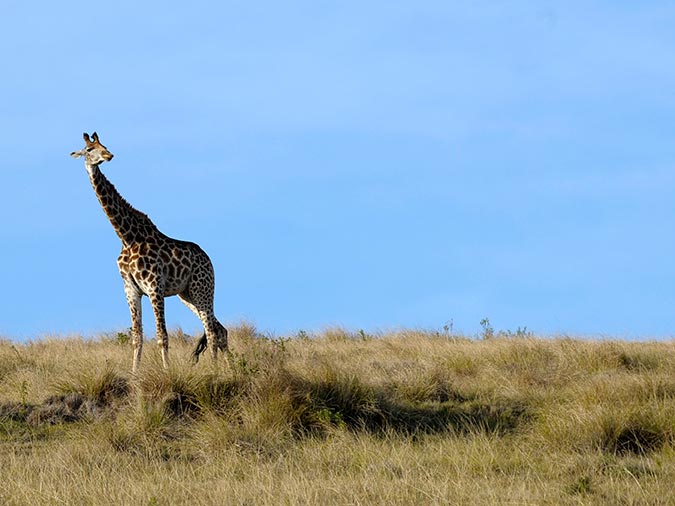Scientists work out exactly why giraffes look so strange and how they got their long necks
After getting a full picture of a giraffe's genome, scientists can understand a lot more about how it came to be – and hopefully help secure its existence in the future

Your support helps us to tell the story
From reproductive rights to climate change to Big Tech, The Independent is on the ground when the story is developing. Whether it's investigating the financials of Elon Musk's pro-Trump PAC or producing our latest documentary, 'The A Word', which shines a light on the American women fighting for reproductive rights, we know how important it is to parse out the facts from the messaging.
At such a critical moment in US history, we need reporters on the ground. Your donation allows us to keep sending journalists to speak to both sides of the story.
The Independent is trusted by Americans across the entire political spectrum. And unlike many other quality news outlets, we choose not to lock Americans out of our reporting and analysis with paywalls. We believe quality journalism should be available to everyone, paid for by those who can afford it.
Your support makes all the difference.Genes that help form the skeleton, heart and nervous system could explain how the giraffe got to be quite so tall, according to researchers.
Scientists have finally plotted out the genetic instructions that led to the creation of the mysterious giraffe, which they say is one of the strangest – and thus far unexplained – creatures on Earth.
Looking at that code or genome has helped scientists work out exactly what parts of the DNA led to the animal becoming quite so long-necked and strange-looking.
Standing up to 19ft (six metres) tall, the giraffe's peculiar body is dominated by its stretched out legs and neck.
Professor Douglas Cavener, from Pennsylvania State University in the US, who led the new study, said: "The evolutionary changes required to build the giraffe's imposing structure and to equip it with the necessary modifications for its high-speed sprinting and powerful cardiovascular functions have remained a source of scientific mystery since the 1800s, when Charles Darwin first puzzled over the giraffe's evolutionary origins."
The animal's heart, built to pump blood vertically a distance of two metres (6.5ft) to its brain, has an unusually large left ventricle chamber.
Taking a giraffe's blood pressure would show a reading twice as high as that of other mammals.
The giraffe can also sprint at speeds of up to 37 mph on its long spindly legs, and despite appearances its neck contains the same number of bones as seen in other mammals, including humans. The big difference is that both the giraffe's leg and neck bones are greatly extended.
"At least two genes are required - one gene to specify the region of the skeleton to grow more and another gene to stimulate increased growth," said Prof Cavener.
The scientists pinpointed unique regions of the genome by comparing it with that of the giraffe's close relative, the okapi.
Both animals have a common ancestor but branched off in separate directions along the evolutionary path around 11 to 12 million years ago.
The okapi has similar gene sequences to the giraffe, but lacks its lanky features and looks more like a zebra.
A battery of tests comparing the two animals uncovered 70 giraffe genes that showed multiple signs of adaptation. More than half of these coded for proteins known to regulate the development of the skeletal, cardiovascular and nervous system.
Several genes controlled both heart and artery and skeletal development - raising the intriguing possibility that the giraffe's stature and cardiovascular system were modified together through changes to a small group of multi-purpose genes.
One key gene is thought to be FGFRL1, which regulates a biological pathway critical to bone growth. In addition, four "homeobox" genes were identified that are known to specify the regions of the spine and legs.
"The combination of changes in these homeobox genes and the FGFRL1 gene might provide two of the required ingredients for the evolution of the giraffe's long neck and legs," said Prof Cavener.
Further discoveries included metabolic genes that may allow the giraffe to feed on acacia leaves and seedpods, which are both highly nutritious and toxic to other animals.
It is hoped publication of the genome in the journal Nature Communications will raise awareness of the plight of the giraffe, whose numbers in the wild are dwindling.
Prof Cavener added: "While the plight of the elephant - giraffe's shorter companion in the African savannah - has received the lion's share of attention, giraffe populations have declined by 40% over the past 15 years due to poaching and habitat loss.
"At this rate of decline, the number of giraffes in the wild will fall below 10,000 by the end of this century. Some giraffe subspecies already are teetering on the edge of extinction."
Additional reporting by agencies
Join our commenting forum
Join thought-provoking conversations, follow other Independent readers and see their replies
Comments